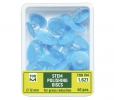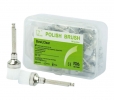Although people may see white spots on their teeth as undesirable, they rarely need to be a serious cause for concern from a medical point of view.
In this article, we look at the reasons why people might get white spots on their teeth, and provide 11 tips for treating and preventing them.
Causes
A common cause is dental fluorosis.
People usually get this when they are young if they consumed too much fluoride as a child. It is usually a harmless condition that only tends to develop before the teeth break through the gums.
Another common cause is enamel hypoplasia.
This condition occurs when a person's teeth enamel does not form properly. Like fluorosis, hypoplasia only occurs during childhood when a person's teeth are still developing. However, it can increase the risk of tooth decay.
Other causes of white spots on the teeth include poor dental hygiene, especially when someone is wearing braces, or eating too many acidic or sugary foods.
Treatments
There are several possible treatments for white spots on the teeth. The suitability of these treatments may depend on the underlying cause of the white spots and the condition of a person's teeth.
1. Enamel microabrasion
Some people may be able to have microabrasion done to treat their white spots. During this procedure, a dentist removes a small amount of enamel from the teeth to reduce the appearance of the white spots.
This professional treatment is typically followed by teeth bleaching, which can make the teeth appear more uniform in color.
2. Composite resin.
For people with enamel hypoplasia, a dentist may apply composite resin to fill in cavities and to bond the outer enamel of the teeth. This may not be suitable if people have large numbers of white spots on their teeth.
3. Using the right amount of toothpaste
For children under the age of 3 years old, people should ensure that they are not using more than a smear of toothpaste, or an amount the size of a grain of rice, on their toothbrush.
For children over the age of 3 years old, carers should ensure they are not using more than a pea-sized amount of toothpaste.
Young children often fail to spit toothpaste out, so using a small amount can help reduce their overall fluoride exposure. Supervising a child's brushing can help to ensure that they are using an appropriate amount of toothpaste and not swallowing too much.
4. Reducing sugary and acidic foods and drinks
Tooth enamel can be damaged and the risk of tooth decay increased by some foods and drinks, especially ones high in sugars or acids.
Foods and drinks to be aware of include the following:
- citrus juices and fruits, such as grapefruit, lemons, and oranges
- hard candies and other sugary sweets
- sodas and other drinks high in sugars, including sports drinks
While occasionally eating these foods and drinks may be harmless, eating too much or too many can lead to damage and blemishes, including white spots.
Drinking water after consuming these foods can help wash them off the teeth and reduce the chances of damage. Drinking through a straw may also help.
5. Seeing a dentist
Anyone concerned about their dental health, or that of their child, should talk to a dentist.
Although white spots on the teeth may be less than desirable, they are usually not a cause for concern. However, people with enamel hypoplasia may be at increased risk of dental damage and decay.
If a person notices that the white spots on their teeth are changing in size or number, or they are starting to have tooth pain, they should see their dentist.
A dentist can evaluate the symptoms and condition of the teeth and will recommend a treatment plan, if necessary.


